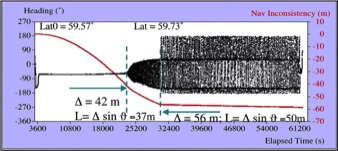Lost or Missing?
An AUV can be known to be lost or it can be missing. It may have sunk in water depths exceeding its depth limit. In this case there is likely to be little that can be done. If the AUV is known to be stopped on the sea bed, or under the ice surface, it is probably disabled, and some form of intervention will be required.
As is the case in open water, AUVs can also be missing for a period of a few minutes to days. In cases where transits are involved, the vehicle will leave an area where positioning and communications are possible and may check-in at pre-planned points along the route. In this case, any loss may only become apparent some time after it occurred.
Check and recheck the Mission Plan
From time to time, AUVs that have gone missing are found exactly where the mission plan took them and a careful review of the mission plan may unearth a simple mistake. Along the same lines, a review of the fault table may provide some clue as to where to look for the vehicle. As there there may be some uncertainty about the status of an AUV that has not been heard from at, or by, an expected time, it may not be prudent to alert higher authorities or the insuring authority immediately. If the vehicle's location is not known, a search may be organised. If the vehicle is on the bottom, it should be quite easy to track the emergency acoustic beacon when it comes within range of the search party or ship. More information is on the Finding a Missing AUV page.
Having located a Missing Vehicle
When the vehicle is located an attempt is usually made to establish communications through a telemetry link. If this is operational, it should provide a synopsis of the vehicle's condition as well as possibly revealing what the problem is. From there, it may be possible to "coax" the vehicle back to the surface, or to resume its mission. If not, it may become necessary to resort to the use of heavier, more sophisticated lift equipment such as ROVs. At this point the economics of a recovery should be re-examined.
Best Practice for Vehicle Loss
As with mission operations, the best practice will take common sense, good judgement and an appreciation for local knowledge into account.
When a vehicle is missing, the mission plan and the fault management program should be examined carefully in an attempt to reconstruct where the vehicle is most likely to be. Common sense and judgement will determine what is the best time to alert authorities and seek outside help.
In the event that the vehicle's position cannot be confirmed, a search should be organised using a receiver to listen for the emergency beacon of the vehicle. Generally, the search should start from the last known position and proceed along the planned track.
As a minimum, a search party or ship should carry a surface acoustic telemetry transceiver and computer as well as a directional receiver. This will allow them to establish communications with the AUV when they find it.
Loss of an AUV
On Mission 186 a bug in the Autosub navigation software that had been there for weeks if not months before it emerged. If a course was held for at least 7 hours without change, and was not North/South or East/West, a navigation error built up (red line). When the error reached 42m the heading of the Autosub wavered, and when it reached 56m the Autosub track became a racetrack. In this unescorted mission the ship went along the intended track of the vehicle and, listening for its acoustic beacon, found the missing vehicle, on track, but going round a racetrack at its programmed depth.


How an AUV may go missing ... but stay exactly on track
